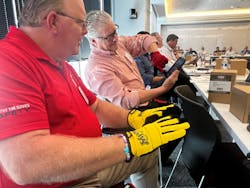Safe practices for tire service are one thing, but those in charge of safety protocols at North America’s tire dealerships are worried about more than just eye protection, proper footwear and what equipment is stowed on a service truck.
Noise levels, isolated workers who hop from one job site to another, and all the dangers on the road are among the big concerns tire dealers are managing. And for a day-and-a-half, safety leaders from some of the nation’s largest tire dealerships gathered to brainstorm and share information on how to keep their employees and teammates safe. Modern Tire Dealer had an exclusive seat at the table.
The fourth edition of the Safety Leadership Summit brought together the largest group yet, with about 50 safety officials representing 20 different tire dealerships and national truck stops, as well as two tire manufacturers and representatives from select safety-minded providers.
And while this group was the brainchild of representatives of two of the largest commercial tire dealerships in the country — McCarthy Tire Service Co. Inc. and Snider Tire Inc. dba Snider Fleet Solutions — this year the group branched out to cover some of the safety issues facing the retail tire industry, as well.
Check out our photo gallery from the 2023 Safety Leadership Summit.
The event in 2023 was hosted by Bridgestone Americas Inc., and Hal Williams, senior health and safety manager for Bridgestone’s non-manufacturing facilities, talked about the tiremaker’s eye on protecting its off-the-road tire operations.
“What are the needs with our off-road business; what can we do this year that we haven’t done, or that we got half-way done but never finished all the way.” Williams said one of the topics that emerged was “lone workers.”
At Bridgestone, the term applies to OTR tire personnel who works alone for more than 30 minutes, or an employee who works without another person within a clear line of sight.
The tiremaker created a standard, which it just deployed beginning in August, and it also requires that the employee takes a visual risk assessment of every work area before any work is begun. Williams says if it’s not safe, the employee is instructed to “move or stop work.” If the technician can fix the hazard, they should do so. If they can’t, he or she is to call someone or perhaps move to another location to mitigate the risk.
“The premise is the technician needs to take a few minutes at the beginning of the shift,” Williams said. “This is a big premise behind the procedure.”
There’s a list of other factors to consider, too, ranging from the time the worker will be alone, the time of day, the nature of the work and what tools are used or how fatigue may increase risks. If a worker is going to be on site alone for more than two hours, there’s a communication process to follow, and check-ins with that employee are being documented. Williams said if a high-risk task is on the agenda, a buddy is required.
Why is the documentation important?
Williams said, “We thought it was the right thing to do. When we do store assessments, we want there to be evidence that we’re following this process. If Hal is out there somewhere and we lose contact, when was the last contact?”
The issue of protecting the safety of lone workers is present in other industries, too. Erin Butler, an account director for AlertMedia, says her company’s mobile app is used in other businesses, including medical caregivers who travel to patients’ homes. She says the goal is “to give your distributed workforce a faster way to get help 24/7 wherever they are — in the office after hours, at an isolated job site, or alone in a workplace.
In the retail space, Sean Galiano, a 32-year veteran of Sullivan Tire Co. Inc., says the tire dealership is focusing on the RIST procedure for all tire service work — in both retail and commercial. That has included equipping locations with all of the necessary tools, and also implementing an in-house torque wrench calibration procedure. Each torque wrench has a unique ID number, and there’s a record of inspections and calibrations.
Galiano, a safety analyst for Sullivan Tire, says, “We’ve posted RIST procedure posters in our showroom to educate customers.”
He admits “it takes a little bit to explain the process (to customers,)” and sometimes Sullivan Tire even brings the wheel from the service bay to the front counter to show the corrosion buildup to a customer.
The discussion around one safety topic in particular has evolved since the initial safety summit in 2019 — the use of dashcams.
In 2021, only one tire dealership in the room had cameras in its fleet. Colony Tire Corp. was leading that pack. But in the two years since, nearly every tire dealership — and there were 20 in the room in 2023 — has adopted the use of dashcams. Some, like Colony, have equipment in every vehicle in the fleet. Others are still in the early or testing phases.
Tony Mullen, director of risk management for Snider Fleet Solutions, said the company had drivers involved in seven accidents in the month of March. “The camera exonerated us in six of those. The seventh was our fault. The cameras paid for themselves.”
Russ Devens, director of safety and risk management at McCarthy Tire Service, says the company has adopted cameras and even hired an extra person whose sole duty is to monitor and manage the fleet of cameras. McCarthy also created a driver of the month award using the driver analytics and scorecard provided by its camera vendor.
He believes the cameras are improving driver behavior, as evidenced by drivers whose scores have improved over time.
“Our No. 1 driver has been No. 1 since the beginning. He never speeds,” Devens says. “We had another driver who was near the bottom, with a score in the 70s, who is now in the 90s.”






